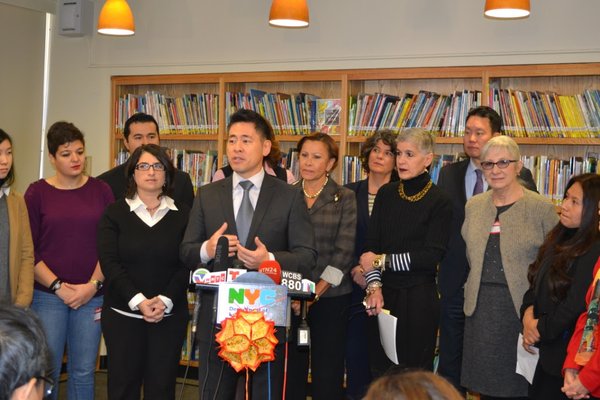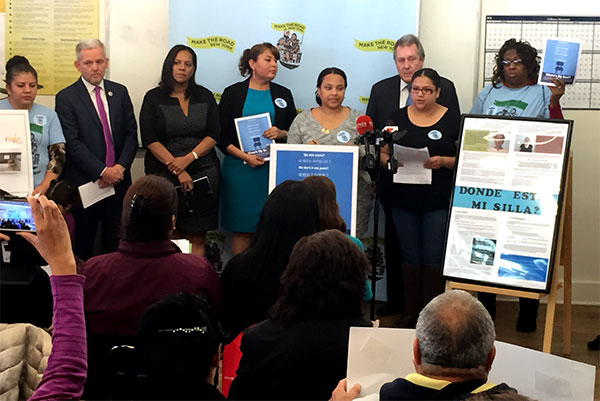The Right Model to Follow for Diversity at Specialized High Schools

Student debaters (photo: @NYCschools)
Last week, 5,000 eighth graders got the exciting news that they were offered admission to one of the city's eight test-in Specialized High Schools, which offer a quality public school education unmatched in the country. But while the vast majority come from poor, working class and immigrant families, as has always been the case, once again far too few come from the black and Latino communities.
Black and Latino students comprise a large majority in the city's public school system and should be better represented among those offered admission to its top high schools. Unfortunately, this year about 500 fewer black and Latino students sat for the test compared to last year, and the percentage of these students offered admission declined as well.
The school system, like the city it serves, is heavily segregated, but this lack of racial and ethnic diversity in our test-in schools is unacceptable for many reasons. Still, doing away with the test as the sole criteria for deciding admission and switching to inherently subjective multiple criteria would do little to ameliorate the imbalance and could make it worse according to last year's study by NYU's Institute for Education and Social Policy.
The city must instead invest the resources – both financial and intellectual – and take proactive steps on both a long-term and an immediate basis in order to diversify admissions to our best schools.
A program of enriched educational opportunity must be instituted in every neighborhood to permit all children to have a fair chance of success on the test and in life. Gifted and Talented Programs must exist in every district. Enriched education, especially in math and English language courses, must be available in every middle school in the city. When 53 percent of the students at test-in schools come from only 15 percent of middle schools, the fundamental answer to the problem of underrepresentation is clear.
Immediate actions must be taken to increase the numbers of students from underrepresented communities sitting for the test. And, increased attention must be paid to better preparing underrepresented students to do well enough on the test to gain admission. There is no fixed passing grade on the test. "Passing" is simply a function of scoring high enough to rank among the 5,000 highest scoring students to qualify for admission to one of the schools.
The Brooklyn Tech Alumni Foundation, which I head, with the support of National Grid, has worked with Brooklyn Tech to run an innovative pilot STEM (Science, Technology, Engineering and Math) Pipeline program for the past three years that reaches out to underrepresented middle schools, identifies children of promise and provides them with accelerated coursework and test prep. The program starts with rising seventh graders and offers them an intensive two year experience with classes during the summers and on Saturdays during the school year.
We have had good success during the first two years that students in the program have sat for the test. This year, students received offers from Brooklyn Tech, Stuyvesant, and Brooklyn Latin, all specialized schools. Half of last year's students in the program – and nearly two-thirds this year – offered admission to Tech are black or Latino.
We are encouraged by the support for diversity at specialized high schools shown by Albany legislators in both chambers who are proposing dedicating funds to create similar pipeline programs in every test-in school. This would cost less than $1.3 million a year, or $2.5 million over two years, and enable all eight specialized high schools to run outreach and test preparation programs in underrepresented middle schools throughout the city.
While Mayor de Blasio is committed to combatting educational and economic inequality, it is still the case that a child's chances of educational success are closely correlated to where he or she grows up. Because test-in schools should serve students from every neighborhood, there is a special obligation to give all promising students tools to succeed.
The answer is not to do away with an admissions test, but to make that promise of social equality real by committing resources and intellectual firepower so that every academically promising child, regardless of their neighborhood, has a fair chance of succeeding on the test, and beyond.
***
Larry Cary is president of the Brooklyn Tech Alumni Foundation.
***
Have an op-ed idea or submission for Gotham Gazette? Email This email address is being protected from spambots. You need JavaScript enabled to view it.
A Good Investment: Supporting New York's Immigrant Communities

Steven Choi, the author (photo via NYC DOE)
New York prides itself on being a gateway of opportunity, a place where people from across the world come to build their businesses, send their children to school, and provide for their families. With more than four million immigrants in New York, these newcomers make tremendous, vital economic, social, and cultural contributions to the Empire State.
And yet there is an enormous amount that our state - led by our elected officials - can do to support our newest New Yorkers move up the economic ladder. That’s why on Thursday, March 10, the New York Immigration Coalition is holding a statewide advocacy day, all the way from Buffalo to Brentwood, to commit to NYIC’s 2016 “Immigrant Blueprint for New York” – the framework for a comprehensive, long-term plan for the state to improve outcomes for immigrant communities and help be a national leader in immigration.
On Thursday, we'll meet with 38 legislators across New York - in Buffalo, Rochester, the Hudson Valley, New York City, and Long Island - to emphasize the needs of their communities.
Our “Blueprint” includes five major pillars for how to achieve immigrant prosperity:
Strengthen integration efforts for New Americans by providing adult education programming for immigrants that need them, and ensuring that limited-English-proficient speakers are able to access government services;
Address the persistent achievement gap for immigrant students and English Language Learners by ensuring tuition equity on the college level, creating multiple pathways to a high school diploma, reducing the required number of Regents exams, and investing in career and technical education;
Provide access to healthcare for immigrants who are excluded from coverage by federal law, and improving access, coverage, and care for immigrants who are eligible to participate in New York’s health exchange;
Advance immigrant justice and uphold due process through ensuring access to affordable and reliable legal services, as well as limiting intrusive and unlawful collaboration between local and state law enforcement and immigration officials to improve trust between communities and law enforcement;
Protect workers’ rights for New York’s most vulnerable, including farmworkers and other low-wage workers exploited by unscrupulous employers, and by meeting basic needs such as including access to driver’s licenses for undocumented immigrants who play critical roles in our economy yet lack tremendous barriers around transportation access.
These strategic steps are not pie-in-the-sky. They are concrete and achievable, and will do wonders for New York’s economic growth - catapulting New York even further as a leader in successful immigrant integration. This March 10, our message is simple: By supporting immigrant communities, we are investing in New York - and we call on our elected officials to use this blueprint to make sure we secure New York’s present and future as the greatest state in the union.
***
Steven Choi is the executive director of the New York Immigration Coalition. On Twitter @SteveChoiNYIC & @thenyic.
***
Have an op-ed idea or submission for Gotham Gazette? Email This email address is being protected from spambots. You need JavaScript enabled to view it.
Addressing NYC's School Overcrowding Crisis

Protesting school overcrowding in Queens
All parents in New York City deserve the peace of mind that their children will be able to attend a school where they can thrive and grow. Unfortunately, following years of neglect from the Bloomberg administration, our city's school system is plagued by school overcrowding and excessive class sizes, where hundreds of thousands of our children simply don't have adequate space to learn.
With education a top priority for the city, it's critical that our leaders take strong action to address the chronic underfunding of our city's school infrastructure. Key to addressing this issue is investing sufficient capital resources in the city budget, as well as improving the current school planning process, which is broken.
Recently, we've had some good news. When the city Department of Education (DOE) released its school capital plan, it included a commitment from Mayor de Blasio to invest nearly $900 million in additional resources to build more school seats. In the same plan, the DOE raised its needs assessment to 83,000 additional seats, given enrollment projections and existing overcrowding. This is closer to the 100,000-seat figure that Class Size Matters estimated in its recent report, "Space Crunch." Together, these two adjustments are a welcome acknowledgement of the crisis in school overcrowding, and we applaud them.
But more should be done. The number of new seats in the capital plan is 49,000—only about 59 percent of the DOE's own admitted need—and New York City's population is growing faster than any other large city in the nation. The mayor is now urging the City Council to adopt rezoning plans to accelerate the construction of thousands of new affordable and market-rate housing units, which will increase pressure on our school system. At this critical moment, the city has a real opportunity to address housing and education together.
Right now, more than half a million students are crammed into over-utilized schools, according to DOE data. In many cases, this means excessive class sizes of 30 or more, a loss of art, music, or science rooms, and a lack of dedicated spaces for students to receive counseling or mandated special education services – no less the wraparound services inherent in the community school model.
According to the analysis in a recent report by Make the Road New York—"Where's My Seat?"—immigrant communities have especially egregious overcrowding problems and even greater unmet needs in the DOE capital plan. In many of the schools in these neighborhoods, children are forced to eat their lunch as early as 10 a.m. or are bused to schools far away from their homes. Many do not have adequate opportunity for physical education because there is not enough space in their gyms.
We need to build, lease, and expand more schools. At least the 83,000 seats that the DOE projects are necessary. In addition, the process of school planning and siting must be made more efficient. There are many communities, like Sunset Park, which have suffered from extreme overcrowding for a decade or more, even though funding to build more schools in the neighborhood has existed in the capital plan, because the School Construction Agency has not been able to site a single one.
According to the DOE, only 15 percent of the school seats needed by 2019 have sites identified and are in the process of being designed. In seven districts, that percentage is zero. The city will fall even further behind in creating seats if the mayor's rezoning proposals are adopted, unless much more is done to build and site schools. A recent Environmental Impact Statement for the East New York rezoning proposal found it would exacerbate school overcrowding, and, along with other changes, drive high school overcrowding in the borough to 109 percent of capacity. Yet the DOE capital plan does not include a single Brooklyn high school to be built.
That is why we are urging the City Council, along with the mayor, to create a commission or task force of experts and stakeholder groups, to propose reforms to the school planning process, so that schools must be built along with housing, instead of decades afterwards. Among the issues to be considered would be reforms to the zoning process, including whether the threshold to consider the need for a new school should be lowered – especially when the schools are already overcrowded; whether the formula used by City Planning to estimate the impact of new housing on schools needs to be updated; whether the city should require impact fees from developers and/or use eminent domain more frequently; and how the trends in lost seats, utilization rates, and enrollment could be made more transparent and more accurate through regular reporting by the DOE.
As Mayor de Blasio repeated in his recent State of the City speech, the goal across our city must be to ensure that neighborhoods thrive. There cannot be successful neighborhoods unless there are schools with enough space for the children in every community across the city to learn and prosper. It's time to invest all the necessary resources and improve the school planning process to ensure the bright future that all of our children deserve.
***
Leonie Haimson is the Executive Director of Class Size Matters. Javier H. Valdés is the Co-Executive Director of Make the Road New York. On Twitter: @leoniehaimson @javierhvaldes.




